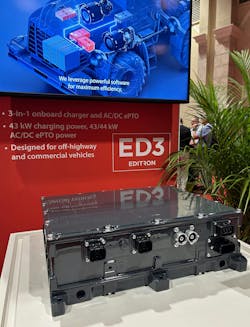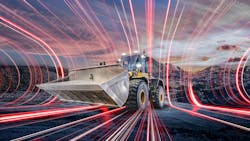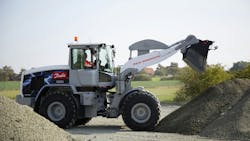Energy Density and Charging are Technology Priorities for EV Advancement
Electrification of various vehicle types has been enabled by the many technological advancements which have taken place in batteries, electric motors and other necessary components in recent years.
As OEMs move into their second and third generation electric vehicle designs, much of the development focus is now placed on system optimization and expanding the applications which can be electrified.
According to Eric Azeroual, vice president of sales development and portfolio at Danfoss Editron, the continued progression of electrification will be dependent upon breakthroughs in battery technology — in terms of energy density — and investments in charging infrastructure, particularly for heavier duty applications.
In this second of a two-part interview series with Azeroual on the current state of electrification, he discusses where technological opportunities exist as well as how fluid power fits into the electric vehicle space.
*Editor’s Note: Questions and responses have been edited for clarity. Read "The State of Electrification: Slow but Continued Growth Ahead" for the first part of this interview series with Azeroual.
P&M: Where is electrification technology today — what is available and what progress has been made in even just the last 2 years to achieve greater electrification?
Eric Azeroual (EA): Danfoss is really entrenched in many areas of the electrification of commercial vehicles and passenger cars. We provide, in some cases just components, but they're critical components. In other cases, we provide a system. And I'll give you an example. We provide the power modules, so the switches that go inside the inverters — basically the component that converts the electric energy from the battery to the motor and vice versa — for a lot of the electric passenger cars that you see on the road.
We also work on charging infrastructure. We have a few customers that are buying our systems and subsystems to build high power, 300- and 400-kW chargers as well. So, we get [into the market] from the smallest component on the vehicle to the charging infrastructure.
Danfoss Editron provides an onboard system — the inverter, the motor, the onboard charger. The sweet spot of Danfoss has always been to offer not just a commodity but something that is harder to get into because we don't like to go into a market and then be squeezed on prices. We've developed these products to be well integrated, well adapted to the commercial vehicle space. The passenger car industry has developed, let's say the core technology, and then what we did is we took it and made it more robust, more durable and reliable for commercial vehicles, which also means more expensive, but we built it to be capable of handling the higher weight, load, g-force, and vibration. Trucks are built for millions of kilometers, cars are built for hundreds of thousands of kilometers, so it's a different requirement.
We looked at the market and said, ‘How long is it going to take for the commercial vehicle market to develop, and what are the barriers?’ And really, it came down to charging infrastructure. And so, we asked ourselves, what is going to enable the commercial vehicle space to electrify, what is going to be that bridge component, and that is the onboard charger.
Charging at home made electric passenger cars possible. Imagine if you could not charge at home at a reasonable rate and you always had to depend on going somewhere to charge. Electric vehicles would have been dead in the water, right? So, how do we make sure that trucks can charge at a depot overnight? Those are the vehicles that need to be charged over an 8-hour period. And to do that, we right sized it to be a 43-kW onboard charger that could be good enough to charge the battery of a truck overnight, at low cost and also over a longer period of time. Most of our competitors have half the power that we do, and so being able to have twice the power means we could charge either twice as fast or charge a bigger battery in the same amount of time.
P&M: What challenges still exist with electrification — either from a technological perspective or just the general trend itself — and how can these be overcome?
EA: There's always going to be consolidation of components. Generation one electric vehicles, you're trying to put whatever you can in a vehicle, and then generation two you are optimizing it a little bit. Generation three, you're going to bring all these components into a more compact system. Basically, the technical challenge we have left is really, how long is it going to take to charge and how heavy is that battery going to be? For commercial vehicles, it's all about payload. Even if I can fit a huge battery on a truck, it is affecting the dollars per kilograms that I can transport, because it's super heavy. In commercial vehicles, you're limited by the weight on the road. You can't just add more weight, you're going to be overloaded.
It would be a benefit if you reduce weight, so the technology is going to go to lighter, more energy dense batteries — smaller battery packs for the same amount of energy is a way to put it. That's going to be a pretty advanced breakthrough. Inverters are efficient today at 99%. We can make it more compact, more cost effective, but versus the benefit that we're going to get out of it, it's nothing compared to the battery. The motor is the same. There are some improvements being made on combining the motor and the axle of the truck and the inverter on the axle to have a very compact system, again, just like the passenger car market is already doing. But is that really a breakthrough? No, I don't think so. The breakthrough is really energy density.
READ MORE: The Current State of Battery Technology
The charging infrastructure is pretty challenging, because you need to work with governments, municipalities, and utilities; this is really a big undertaking. It's not let's just do it. Today, if you talk to the OEMs, they're very disappointed in their electric vehicle sales. They have the trucks, they work and they're good. They're expensive, but they're subsidized as well. Still, the uptake is not as big as they thought it would be.
The problem is when you sell these trucks you need to educate the customer as to how they are going to charge it — do they need to upgrade the electric of the plant or the depot to charge these trucks? Maybe. Maybe not. The whole ecosystem is not fully mature. The ones that are successful are the ones that are coming [to market] with a total package. They come in, they do an assessment of your facility, they look at your power, they're like “Okay, it's going to work” or “It's not going to work.” And in some cases, if you need to bring a new line from the utility because the power is not enough, then you're talking about years of delay. Electrification is going to happen in the commercial vehicle market, but it's not going to happen as fast.
But what I'm happy to see is all the developments taking place. In trucking, there are two costs. There's the cost of the driver and the cost of fuel. Electrification will reduce the cost of fuel, but the cost of the driver is still there. Another innovation that's happening is automation, or self-driving trucks. That's potentially a huge benefit. If you have that intelligence of how to drive the truck, how to drive it most efficiently when it's climbing the hill, going down the hill, when to brake, when not to brake, and how to manage the power onboard the vehicle, when the charging infrastructure is available, you're starting to have an ecosystem that's super smart and that could charge at the right time, at the right rate.
Although those two technologies are developing kind of in parallel, I think the full self-driving capabilities of a truck will continue developing, even on conventional trucks. That technology, once it's mature and ready, is going to complement the electrification technology very well and make a very good vehicle.
READ MORE: The Intersection of Electric Drive and Automation Technologies
P&M: With electrification, people wonder where hydraulics and pneumatics technologies will continue to fit in. How does Danfoss see those technologies being used as electrification increases?
EA: We spoke a lot about commercial vehicles but actually most of our focus today is on off-highway — construction, agriculture, port machinery, all those heavy applications. It's interesting because off-highway has been using electrification for the longest time, they were just connected directly to the grid or to a generator. If you take mining and harbors, for example, they have used electric, it's just not been battery powered — it’s been grid powered.
The maturity of that customer base is very high on electrification. They know exactly how much power they need, where the [electrical] panel is, what upgrade they need, and how they're going to use it. They're very knowledgeable about it. They know that once they put a battery on it, they're going to remove the cable from the grid. For them, you need to talk about the fuel savings that they're going to get by removing the generator, or the efficiency that they're going to gain because of the reaction time and so forth. And of course, cost of the equipment because once there's no engine, there's no more maintenance, there's no more emissions and noise, which are very big in these areas.
So, hydraulics for us are going to continue playing a very big role. Electric motors are very powerful but in terms of torque density — how much torque you get in a given space — hydraulic is higher, and so you can pack much more torque density in a smaller space than with an electric motor. That means for selected applications, you basically take out the engine, but you drive the hydraulic pump with an electric motor, so you keep the hydraulic system in place. That's why we believe electric hydraulic is going to be the best transition for off-highway, and it's going to continue for a very long time until we develop electric solutions that can have equal torque density to hydraulics.
For smaller vehicles we could do them in full electric and for other vehicles, we remove the engine and drive the hydraulic pump with an electric motor attached to a battery pack, and that's how you electrify the machine. You get significant efficiency gains, but you still keep the hydraulics in place.
READ MORE: The Impacts of Electrification on Fluid Power Systems
About the Author
Sara Jensen
Executive Editor, Power & Motion
Sara Jensen is executive editor of Power & Motion, directing expanded coverage into the modern fluid power space, as well as mechatronic and smart technologies. She has over 15 years of publishing experience. Prior to Power & Motion she spent 11 years with a trade publication for engineers of heavy-duty equipment, the last 3 of which were as the editor and brand lead. Over the course of her time in the B2B industry, Sara has gained an extensive knowledge of various heavy-duty equipment industries — including construction, agriculture, mining and on-road trucks —along with the systems and market trends which impact them such as fluid power and electronic motion control technologies.
You can follow Sara and Power & Motion via the following social media handles:
X (formerly Twitter): @TechnlgyEditor and @PowerMotionTech
LinkedIn: @SaraJensen and @Power&Motion
Facebook: @PowerMotionTech

Leaders relevant to this article:





